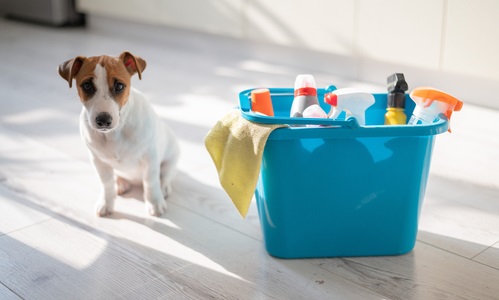As 2020 winds down, there is unfortunately no shortage of new Covid-19 cases popping up in the news. Although the general population continues to wear masks, limit interactions with one another, practice social distancing, and use hand sanitizer liberally, the novel coronavirus remains a cause for concern for people around the world. However, pet parents to four-legged friends may be wondering “Is hand sanitizer toxic to dogs?”, and with good reason, since it has become such a prevalent part of everyone’s daily routine. In fact, it’s no wonder it has become a legitimate worry for many dog owners, since alcohol based hand sanitizer can be found in nearly every part of the home, in public spaces, and even inside the family car. Read on to learn the dangers of canine hand sanitizer ingestion, and how to prevent dogs from consuming it.
The Dangers Of Alcohol Based Hand Sanitizer & Your Dog
While Purell® may not be the most tempting option to pups, some dogs are known to get into mischief – and eat whatever is laying around. Most hand sanitizer contains ethanol (also known as ethyl alcohol) – the very same ingredient that’s found in liquor, wine and beer. Keeping this in mind, although hand sanitizer isn’t usually palatable to canines, it can be dangerous to dogs if consumed in large quantities. Depending on the brand of hand sanitizer, it can contain between 60% to 95% ethanol by volume, which is enough to cause serious harm if ingested by the family pooch.
According to the FDA, only two alcohols are allowed as active ingredients in alcohol-based hand sanitizer products: ethanol or isopropyl alcohol (also known as isopropanol or 2-propanol). However, there are also additives found in some hand sanitizers known as denaturants. Denaturants are added to the list of ingredients in order to make it less appealing to consume – specifically, young children. The denaturants make the hand sanitizer taste so terrible that if a child does consume it accidentally, he will usually stop eating it after only one taste. Similarly, most dogs who get into a container of hand sanitizer will likely be turned off by the taste immediately. However, a pet parent should know 1) how to prevent such accidents and 2), what to do in case of an emergency.
Hand Sanitizer & Your Pet: Preventative Measures Every Pet Parent Should Know

It’s no secret that dogs are curious about their surroundings – and often get into things they shouldn’t, including non-edible items around the household. That’s why it is so important to pet-proof the home: similar to child-proofing one’s environment, pet parents should be mindful of keeping toxic chemicals, cleaners, cosmetics, perfumes, and yes – hand sanitizers – out of harm’s way of their animal. As a rule of thumb, it’s always best to store hand sanitizer out of reach – and out of sight – for both pets and children. Additionally, always have the vet’s phone number on speed dial, as well as a hotline for pet poisoning control in case of emergencies. Below, a few helpful hand-sanitizer hints to keep inquisitive pups safe and sound:
Lock it up: Wherever there are storage options available around the house, keep hand sanitizer products (including liquid/gel form, wipes, and spray alcohol formulas) out of reach of the family dog, preferably in a closet or drawer where he can’t get to them. Go one step further for the clever pooch who’s learned how to open cabinets and doors: use baby-proofing systems on kitchen cabinets, and install hook-and-eye locks up high on closets doors where such items may be stashed. In the car, be sure to store travel-sized hand sanitizers in the glove compartment or in a place the dog can’t access it. For women who carry a handbag, it’s best to tote mini sanitizers either inside the purse’s side compartments, or securely zipped up in a cosmetic bag.
Keep him crated: For dog owners who are gone for extended periods of time and must keep the pup at home, some canine experts suggest crate training him. This can be particularly helpful for the dog’s safety, especially if he has separation anxiety and/or becomes destructive – which may include getting into random things laying around the house. This shouldn’t be seen as a punishment: in fact, many dogs actually don’t mind the secure feeling a crate provides, particularly if it’s lined with their favorite blanket, toys, tasty treats and water. Since a dogs’ ancestry goes back to bedding down in the wild, a crate mimics that nesting-like sensation for them. Be sure to purchase a crate that’s appropriately-sized for the dog, and acclimate him to it if he’s not used to being crated – check out this video by the Human Society for useful guidelines and information.
Use a pet camera: For pet folks who prefer to let their pooches roam freely in their absence, pet cameras are a great way to keep tabs on their fur babies. Some pricier versions even allow owners to ‘talk’ to dogs from the app through their cell phone, with features that enable parents to speak to lonely or frightened pets through their mobile device. Most importantly, though, it offers doggy moms and dads the peace of mind of seeing what their pups are up to – and if need be, an emergency contact can be reached to check in on him.
Help! My Dog Got Into The Hand Sanitizer – Now What?

Now that hand sanitizer has become such an ingrained part of most people’s everyday regimen, it has raised some anxiety with pet owners. Although it can be harmful if ingested in large quantities, parents needn’t worry if the dog licked a family member’s hand post-sanitizer – in such miniscule amounts, it does not pose a health risk. According to the experts at the American Kennel Club, “The amount of ethanol needed to cause intoxication varies depending on its concentration in the substance ingested.” In other words, depending on his size, weight, and health, dog owners need to be mindful of a pup’s activities – smaller pooches are more likely at risk, since the ratio of alcohol strength to their diminutive proportions could easily be toxic. For anyone who suspects their dog has gotten into the hand sanitizer, a call should be made to the vet or the pet poison control hotline immediately.
As noted on the Pet Poison Helpline site, common symptoms a dog will display if he’s ingested too much alcohol may include:
- Lethargy
- Drooling
- Weakness
- Vomiting
- Incoordination
- Collapsing
- Coma
- Decreased respiratory rate
- Low blood pressure
- Low blood sugar
- Low body temperature
- Neurological depression
- Seizures
- Respiratory failure
- Potential death (if a large amount is consumed)
If any of these symptoms are observed or it appears that the dog has consumed hand sanitizer, be sure to contact the family veterinarian right away. In most instances, they will ask what sort of hand sanitizer the dog ingested, as well as the ingredients printed on the container. The clinic will likely ask how much the dog may have consumed. Based on the answers provided, they will be able to determine whether or not it is necessary to bring the dog to the vet’s office, and next steps, if any.
Is It Safe To Touch My Pet After Using Hand Sanitizer?

Another concern that has made the rounds on social media this past year: is it safe to touch one’s pet after using hand sanitizer? Claims on various forums claimed that petting dogs (or pets accidentally licking a person’s hand) could kill them, stating that “hand sanitizer has the same ingredients as antifreeze” – and consequently stirring a lot of panic for pet owners around the globe. However, according to this fact-checked article as seen on Reuters, these claims are false: “While ingesting a large amount of hand sanitizer could hurt a pet, animals are not in danger from being touched by a person who has cleaned their hands with it, or from licking their hand.”
Summary: Remain Proactive For Your Dog’s Safety
All dog lovers want what’s best for their fur babies: their safety and well-being. That’s why it is so essential to take precautions around the home, as well as any environment where hand sanitizer may be left out for curious pups to encounter. Whether in the household, at a friend’s apartment, in the car, or anywhere that a dog may be spending an extended amount of time, be sure that potential toxins are out of his reach. From hard liquor and bathroom cleaning supplies to body sprays and hand sanitizers, keep hazardous items either stashed up high or locked away where dogs cannot get a hold of them. By remaining proactive and managing his environment, pet parents can keep their favorite four-legged friend safe and healthy wherever they may wander.
Sources Cited:
- Ollila, Erin. “Is Hand Sanitizer Bad for Dogs? (& What to Do if They Eat it).” Hill’s (hillspet.com), July 30, 2020, https://www.hillspet.com/dog-care/healthcare/is-hand-sanitizer-bad-for-dogs. Accessed November 20, 2020.
- “Hand Sanitizer (Ethanol).” Pet Poison Helpline (petpoisonhelpline.com), (no published date), https://www.petpoisonhelpline.com/poison/hand-sanitizer-ethanol/#:~:text=Toxicity%20to%20pets,blood%20pressure%20and%20body%20temperature. Accessed November 20, 2020.
- Klein, Dr. Jerry, CVO. “What To Do If Your Dog Drinks Alcohol.” American Kennel Club (akc.org), September 24m 2019, https://www.akc.org/expert-advice/vets-corner/is-alcohol-dangerous-for-dogs/. Accessed November 20, 2020.
- Reuters Staff. “False claim: If you touch your pet after using hand sanitizer, its highly toxic ingredients can kill it.” Reuters (reuters.com), April 29, 2020, https://www.reuters.com/article/uk-factcheck-handsanitizer-pets/false-claim-if-you-touch-your-pet-after-using-hand-sanitizer-its-highly-toxic-ingredients-can-kill-it-idUSKBN22B2OJ. Accessed November 20, 2020.
- “Valuable Real Information about Hand Sanitizers and Pets.” Steve Dale CABC (stevedalepetworld.com), March 16, 2020, https://www.stevedalepetworld.com/blog/valuable-real-information-about-hand-sanitizers-and-pets/. Accessed November 20, 2020.
.




